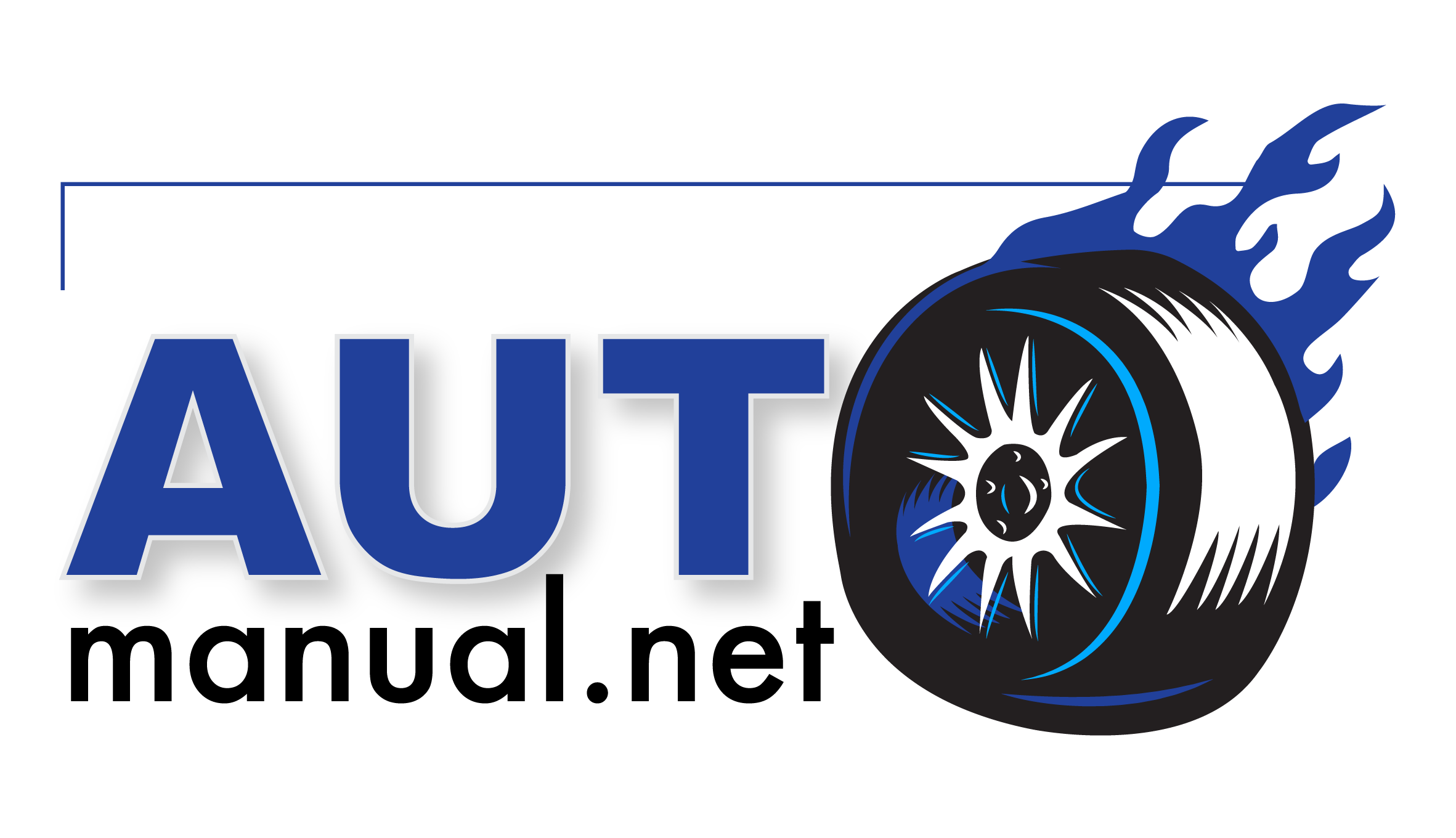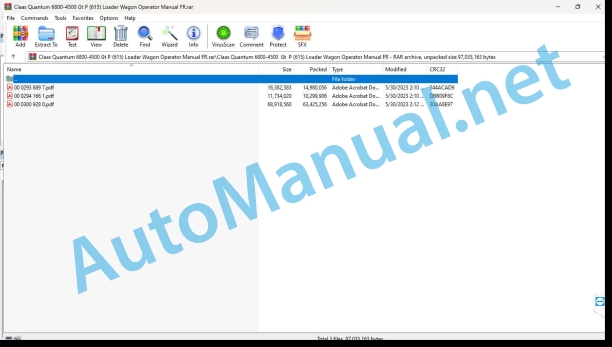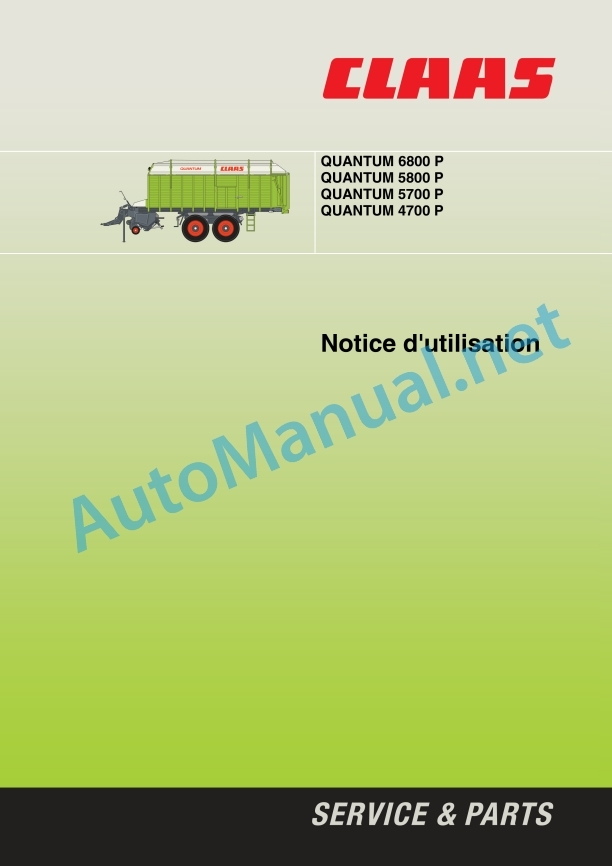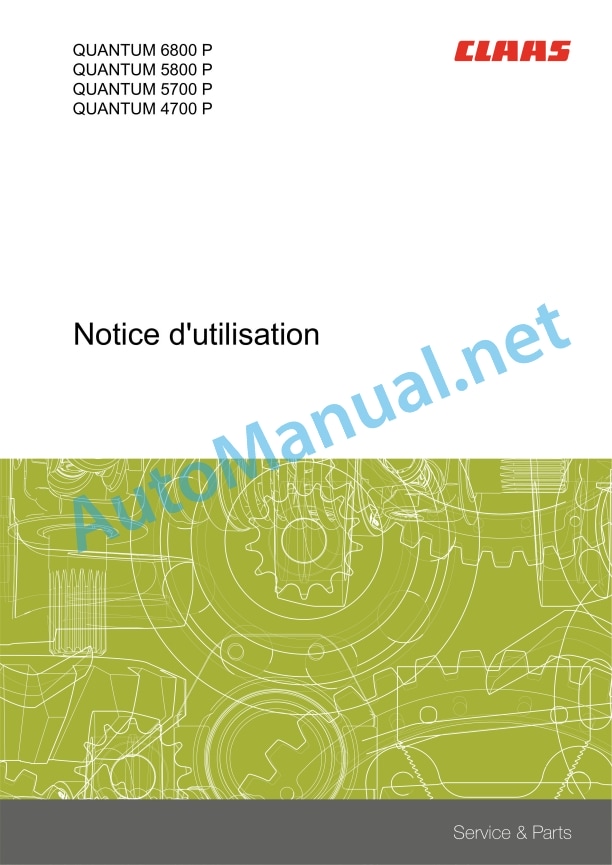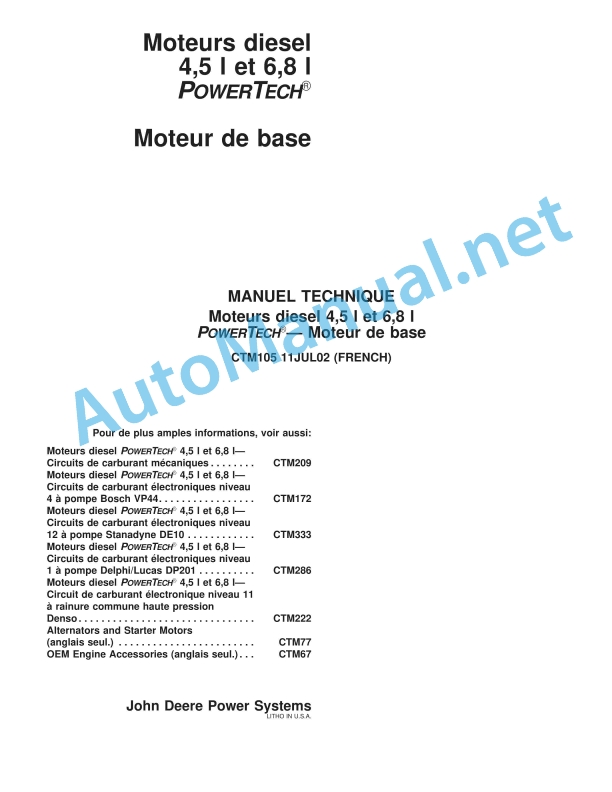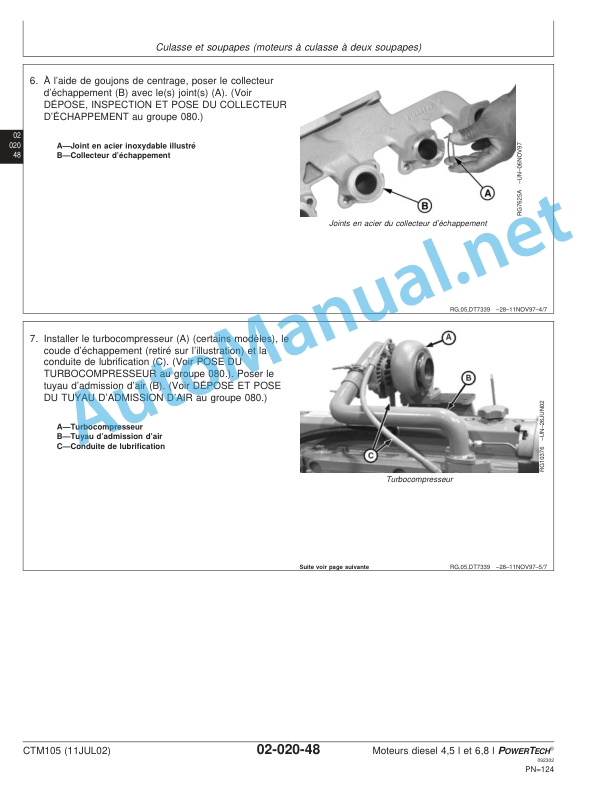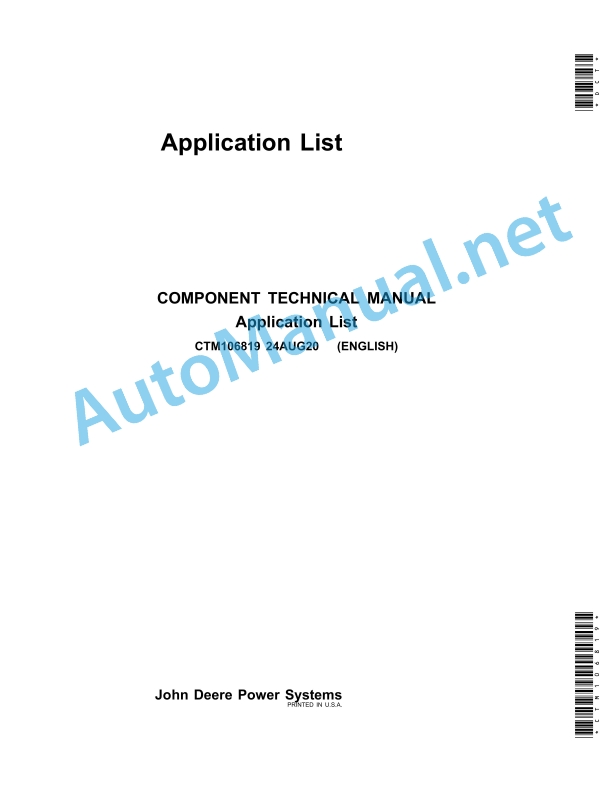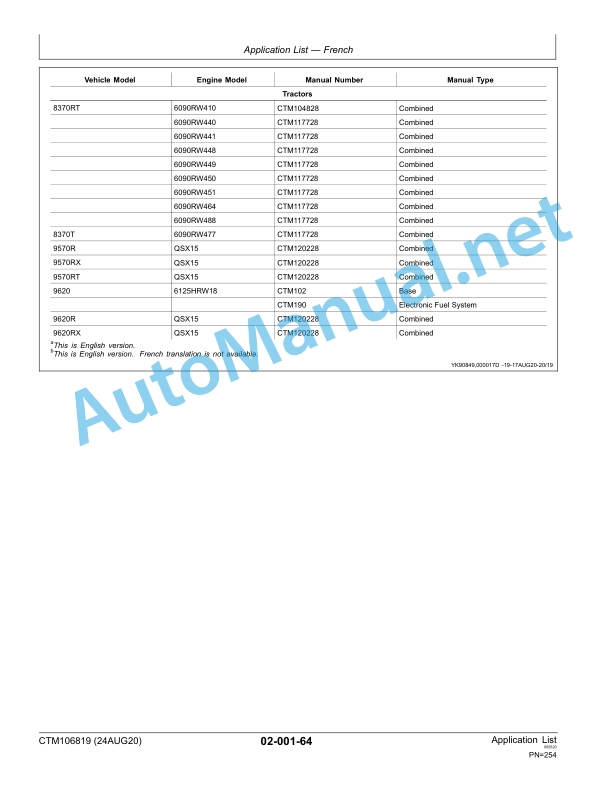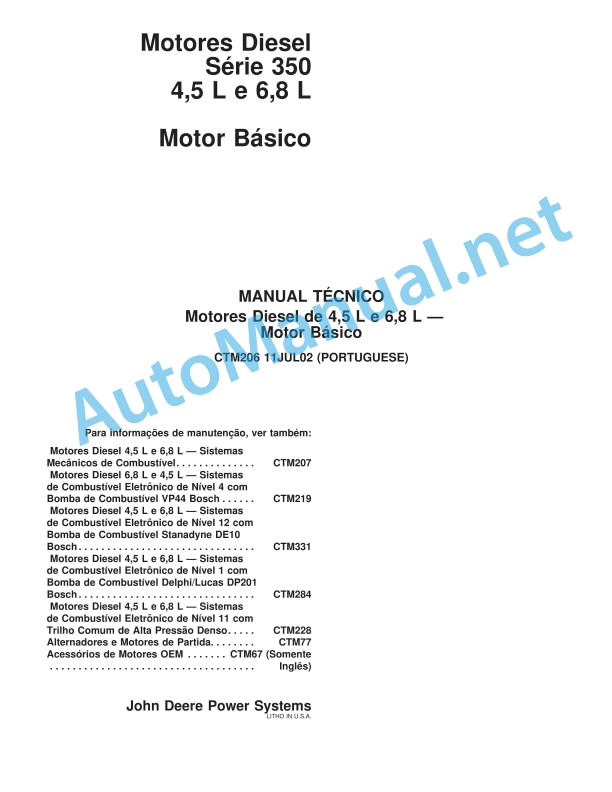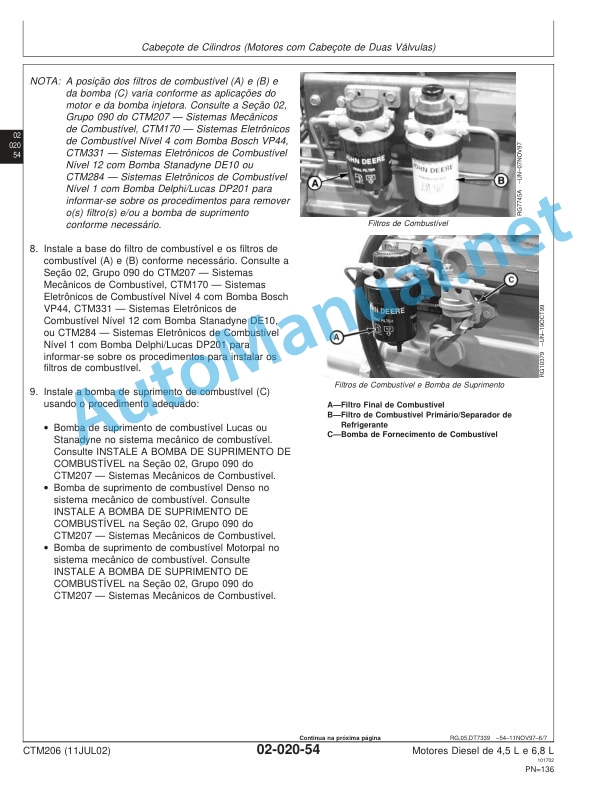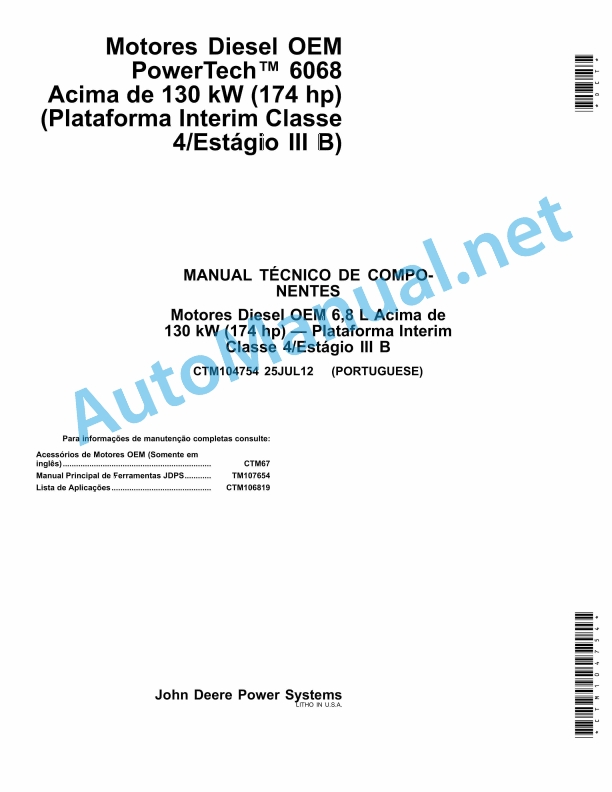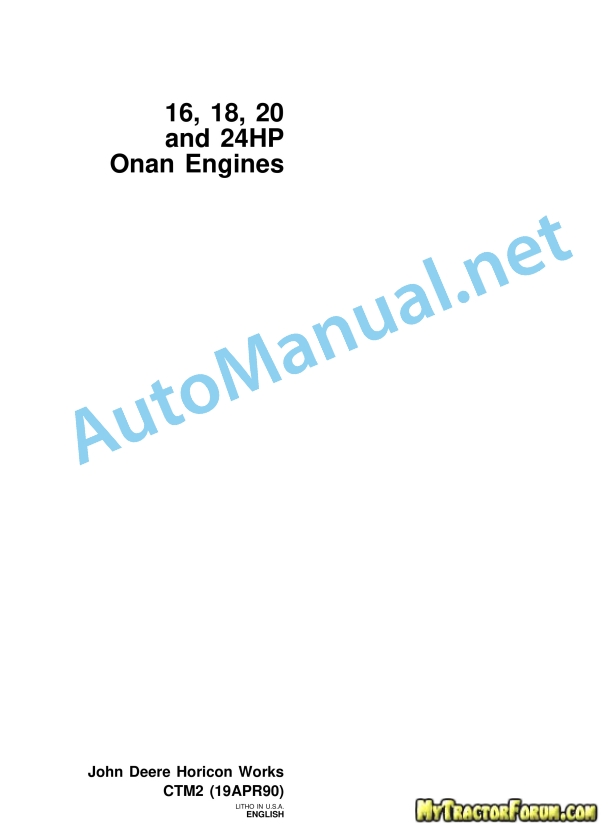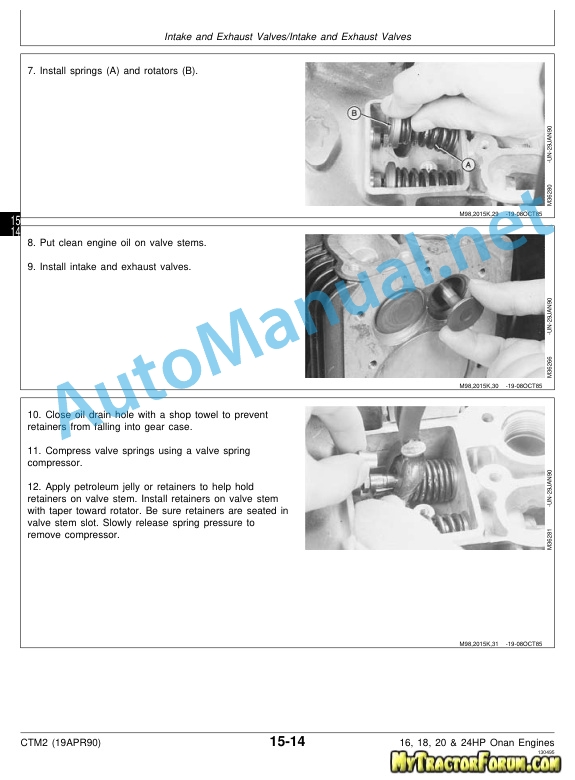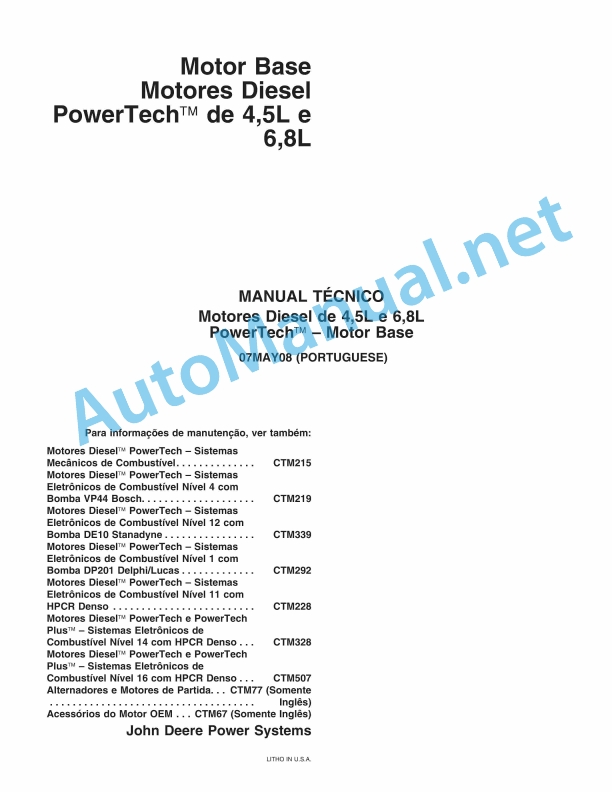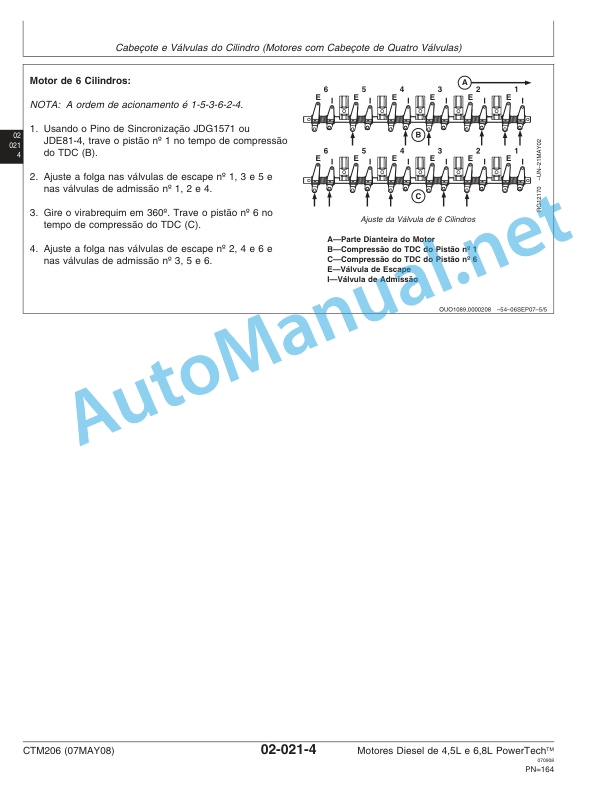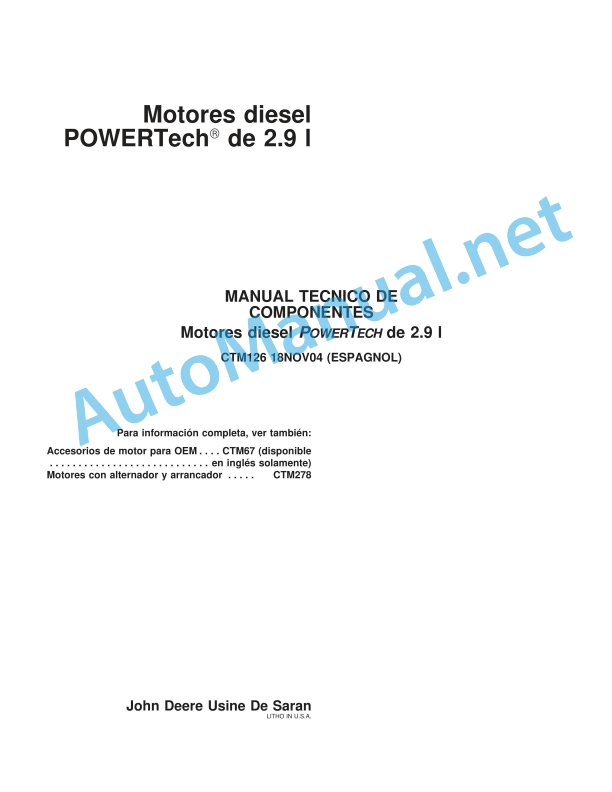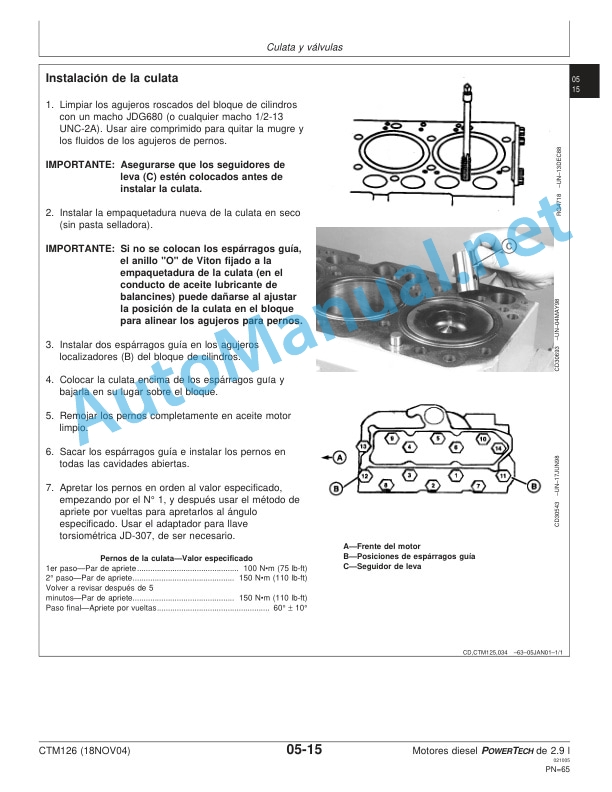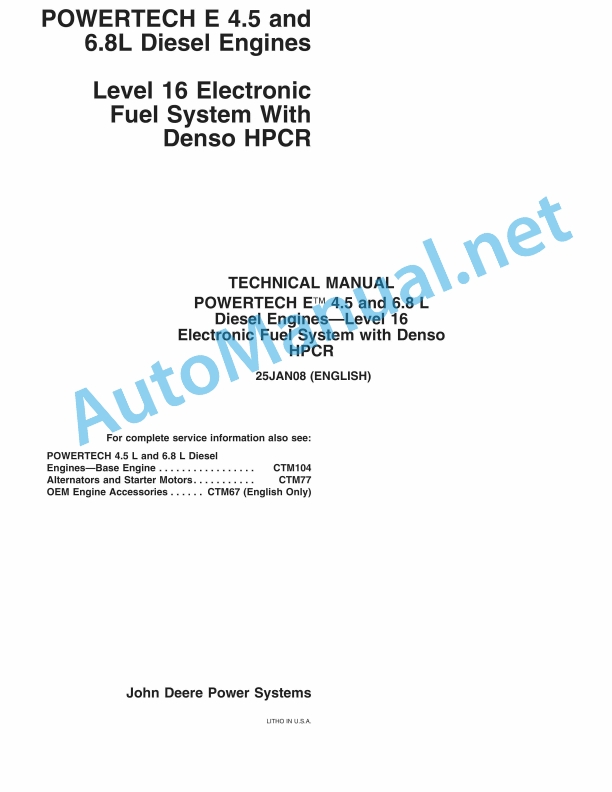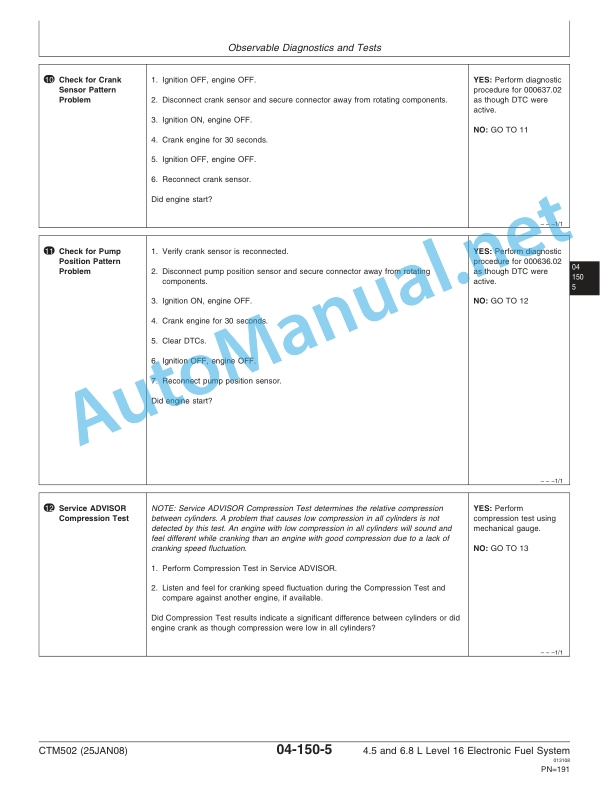Claas Quantum 6800-4500 Gt P (615) Loader Wagon Operator Manual FR
$50.00
- Model: Quantum 6800-4500 Gt P (615) Loader Wagon
- Type Of Manual: Operator Manual
- Language: FR
- Format: PDF(s)
- Size: 84.6 MB
File List:
00 0293 689 7.pdf
00 0294 166 1.pdf
00 0300 928 0.pdf
00 0293 689 7.pdf:
1 Machine overview
2 Introduction
Introduction
Validity
3 Table of contents
4 General tips
Important
Nameplate
Driving license
Traffic on public roads
Numberplate
Regular checks according to Article 29 StVZO
5 Safety Tips
Use as intended
Marking of warnings and dangers
General safety and accident prevention regulations
Using the PTO shaft
Hydraulic system
Wheels/tyres, bolts
Interview
Sound pressure level
Safety stickers with warning pictograms
6 Technical characteristics
QUANTUM 6800 P
QUANTUM 5500 P-18
QUANTUM 6500 P
QUANTUM 5500 GT / 5500 P-16
QUANTUM 5500 P
QUANTUM 4500 P
7 Assembly
Assembly
QUANTUM 6800 P / 5500 P-18 up to machine No. 615 0 2366
QUANTUM 6500 P (only in Spain)
QUANTUM 5500 P-16 / 5500 GT / 5500 P up to machine No. 615 0 2366
QUANTUM 4500 P up to machine No. 615 0 2366
QUANTUM 6800 P / 5500 P-18 from machine No. 615 0 2367
QUANTUM 5500 P-16 / 5500 P from machine No. 615 0 2367
Attaching the machine for the first time
8 Before commissioning
Before putting the machine into operation, check the following points!
Coupling
Hydraulic articulated drawbar
Hitch eyes
Articulated hydraulic drawbar – Hitch hitch
Hitch hitch only – Spain
Drawbar height adjustment
Hitch the power steering (optional equipment)
Adjust power steering
Check/adjust hydraulic pressure
Cardan shaft
Adapting the cardan shaft
Cardan shaft with CC clamping cone closure
Uncouple
Electrical system
Control panel
Driving lighting
Compressed air ABS braking system
Checking ABS operation
Hydraulic
Open hydraulic system (standard system)
Closed hydraulic system
Power – beyond
Standard steering axle hydraulic connection (optional equipment)
Adjust the flow on the hydraulic control block
After the self-loader hitch operation
Removing the self-loader
Pneumatic brake system
Two-line system
Maneuvers with a tractor without air brake
Hydraulically operated brake
Parking brake
To apply the brake
To release the brake
Brake blocks
access panel
Uncoupling
Self-loading machines with compressed air braking system
Self-loading machines with hydraulic brake
Self-loading machines with compressed air ABS braking system
Before transportation
Hydraulic drawbar suspension (optional equipment, only available from factory)
Activate drawbar suspension
Traveling on public roads
Summary notice
Unloading
Articulated drawbar
Control light
2-speed motor (optional equipment)
Lower/raise the pick-up
Preset the working height of the pick-up
Roller blank holder (QUANTUM 6800 P / 5500 P-18)
Chicane (QUANTUM 6500 P / 5500 P-16 / 5500 GT / 5500 P / 4500 P)
Open cutting bucket hydraulically
Engage the moving floor – fill the loading space
Unloading
Open the rear flap
Emptying the crate
Moving floor equipped with a 2-speed motor (optional equipment)
Close the rear flap
Loadspace lighting
Starting the self-loader
Loading operation – general information
After use
Standard steering axle (optional equipment, only available from factory)
Standard steering axle lock
Unlocking the standard steering axle
Emergency response
Optional equipment
Power supply tractor electrical system
Control console extension cable
Hydraulic system control command Load Sensing
Articulated drawbar extension for Hitch hitch (M01/0010)
Hydraulic connection for tractor (R03/0070)
Lifting fork kit
10 Maintenance
Important care instructions
Wheels/tyres
Brakes and axles
Compressed air brakes
Hydraulic system
Lubrication
Security devices
Brakes and axles
Pneumatic brake system
ABS braking system
Purge the compressed air tank
Air filter – piping
Cleaning the filter element
Disassembled air filter piping
Check brake adjustment – brake cylinder piston stroke
Brake regulator
Brake linings
Power steering
Fill/bleed air from power steering
Blow the air out of the steering cylinder
Blow the air out of the steering cylinder
Adjust steering cylinder stroke
Take out the steering cylinder
Retract the steering cylinder
Adjust the power steering operating pressure
Cutting mechanism
Replacement of knives
Dismantling the knives
Mounting the knives
Adjust the scraper hopper
Workouts
Main transmission
Moving floor transmission
Moving floor housing with 2-speed motor
Rotor transmission
Adjusting drive chain tension
Adjusting Pickup Drive Chain Tension
Moving floor chains
Pneumatic suspension
Air suspension axle raising and lowering device
Electrical system
Adjusting Reed Switches
Hydraulic
Replace the pressure filter
Pressure accumulators
Hydraulic hoses
Compressed gas springs
Cardan shaft
coupling
Disengageable cam limiter
Maintenance and lubrication openings
Security devices
Screw assemblies
Connecting elements
Wintering
Lubricant table
11 Lubrication plan
Safety tips
Lubricants
Lubrication
00 0294 166 1.pdf:
1 Machine overview
2 Introduction
Introduction
Validity
3 Table of contents
4 General tips
Important
Nameplate
Driving license
Traffic on public roads
Numberplate
Regular checks according to Article 29 StVZO
5 Safety Tips
Use as intended
Marking of warnings and dangers
General safety and accident prevention regulations
Using the PTO shaft
Hydraulic system
Wheels/tyres, bolts
Interview
Sound pressure level
Safety stickers with warning pictograms
6 Technical characteristics
QUANTUM 6800 P
QUANTUM 5800 P
QUANTUM 5700 P
QUANTUM 4700 P
7 Assembly
Assembly
QUANTUM 6800 P / 5800 P / 5700 P
QUANTUM 4700 P
Attaching the machine for the first time
8 Before commissioning
Before putting the machine into operation, check the following points!
Coupling
Hydraulic articulated drawbar
Hitch eyes
Articulated hydraulic drawbar – Hitch hitch
Drawbar height adjustment
Hitch forced steering (additional equipment)
Basic settings
Set forced steering advance protection
Set forced steering
Check/Adjust hydraulic pressure
Cardan shaft
Adapting the cardan shaft
Cardan shaft with CC clamping cone closure
Uncouple
Tractor lower arm
Electrical system
Control panel
Driving lighting
Compressed air ABS braking system
Checking ABS operation
Hydraulic system
Open hydraulic system (standard system)
Closed hydraulic system
Power – beyond
Standard steering axle from hydraulic connection (additional equipment, only available from factory)
Adjust the flow on the hydraulic control block
After the self-loader hitch operation
Removing the self-loader
Pneumatic brake system
Two-line system
Maneuvers with a tractor without air brake
Hydraulically operated brake
Hydraulic emergency braking
Connection
Parking brake
To apply the brake
To release the brake
Brake blocks
Access panel (QUANTUM 6800 P / 5800 P only)
Uncoupling
Self-loading machines with compressed air braking system
Self-loading machines with hydraulic brake
Self-loading machines with compressed air ABS braking system
Before transportation
Hydraulic drawbar suspension (additional equipment, only available from factory)
Activate drawbar suspension
Traveling on public roads
Summary notice
Unloading
Articulated drawbar
Control light
2 speed motor
Lower/raise the pick-up
Preset the working height of the pick-up
Roller blank holder (QUANTUM 6800 P / 5800 P)
Baffle (QUANTUM 5700 P / 4700 P)
Open/close the cutting chamber
Engage the moving floor – fill the loading space
Unloading
Open the rear flap
Emptying the crate
2-speed moving floor motor (additional equipment, only available from factory)
Close the rear flap
Cargo area lighting
Starting the self-loader
Loading operation – general information
After use
Standard steering axle (additional equipment, only available from factory)
Standard steering axle lock
Unlocking the standard steering axle
Emergency response
Additional equipment
Power supply tractor electrical system
Control console extension cable
Hydraulic system control command Load Sensing
Articulated drawbar extension for Hitch hitch (M01/0010)
Hydraulic connection for tractor (R03/0070)
Lifting fork kit
10 Maintenance
Important care instructions
Wheels / tires
Brakes and axles
Pneumatic brake system
Hydraulic system
Lubrication
Security devices
Brakes and axles
Pneumatic brake system
ABS braking system
Purge the compressed air tank
Air filter – piping
Cleaning the filter element
Disassembled air filter piping
Check brake adjustment – brake cylinder piston stroke
Brake regulator
Brake linings
Forced steering
Fill forced direction / purge
Bleed steering cylinder
Bleed the control cylinder
Adjust the stroke of the control cylinder
Take out the control cylinder
Retract the control cylinder
Adjust the operating pressure – forced steering
Cutting mechanism
Replacement of knives
Dismantling the knives
Mounting the knives
Adjust the cutting bucket
Adjust the scraper hopper
Workouts
Main transmission
QUANTUM 6800 P / 5800 P (transmission product number: 0973 300.0)
QUANTUM 5700 P / 4700 P (transmission product number: 0972 140.0)
Purge valve
Moving floor transmission
Moving floor housing with 2-speed motor
QUANTUM 6800 P / 5800 P / 5700 P (moving floor shaft ø 45 mm)
QUANTUM 4700 P (moving floor shaft ø 40 mm)
Rotor transmission
QUANTUM 6800 P / 5800 P (transmission product number: 0973 301.1)
QUANTUM 5700 P / 4700 P (transmission product number: 0973 492.0)
Adjusting drive chain tension
Adjusting Pickup Drive Chain Tension
Moving floor chains
Moving floor chains (until year of construction 2006)
Moving floor chains (until year of construction 2007)
coupling
Disengageable cam limiter
Cardan shaft
Pneumatic suspension
Air suspension axle raising and lowering device
Electrical system
Adjusting Reed Switches
Hydraulic system
Replace the pressure filter
Pressure accumulators
Hydraulic hoses
Compressed gas springs
Undercarriage
Wheel change
Track lls
Maintenance and lubrication openings
Security devices
Screw assemblies
Connecting elements
Cleaning and maintenance
Daily cleaning
Wintering
Lubricant table
Workouts
Lubrication points
11 Lubrication plan
Safety tips
Lubricants
Lubrication
00 0300 928 0.pdf:
QUANTUM 6800 PQUANTUM 5800 PQUANTUM 5700 PQUANTUM 4700 P
Contents
1 About this user manual
1.1 Notes regarding the instructions
1.1.1 Validity of the notice
1.1.2 Notes on the instructions for use
1.1.3 Symbols and remarks
1.1.4 Optional equipment
1.1.5 Qualified specialist workshop
1.1.6 Notes on maintenance
1.1.7 Notes regarding warranty
1.1.8 Technical characteristics
1.1.9 Spare parts and technical questions
2 Security
2.1 Use in accordance with instructions
2.1.1 Use in accordance with instructions
2.1.2 Reasonably foreseeable misuse
2.2 Safety tips
2.2.1 Instructions for use and other sources of information
Meaning of the instructions for use
2.2.2 Staff qualification and organization
Requirements for all users who work on the machine
2.2.3 Danger for children
Children in danger
2.2.4 Hitching the machines
Couple the tractor to the machine
2.2.5 Modifications to the machine
Constructive modifications
2.2.6 Additional equipment and spare parts
Additional equipment and spare parts
2.2.7 Workstations and passengers
Controlling the machine in operation
Passenger co-pilot during work
2.2.8 Technically impeccable condition
Operation only after inspection during proper delivery
Operation only after proper commissioning
Technically impeccable condition of the machine
Danger due to damage to the machine
Respect the technical threshold values
2.2.9 Risk areas
Risk areas
Do not stand between the tractor and the machine
Projection of objects
Danger when the drive is connected
Risks of injury to the PTO
Risks of injury to the PTO
Danger due to machine elements continuing to rotate by inertia
2.2.10 Protective devices
Maintain protective devices capable of operating
2.2.11 Personal protective equipment
Personal protective equipment
Wear suitable clothing
2.2.12 Safety markings
Keep safety stickers legible
2.2.13 Road safety
Dangers when driving on roads and in fields
Tip-over risks
Prepare the machine for road travel
Park the machine safely
Park the tractor with the machine unattended
Protect the machine from foreign bodies
2.2.14 Operating consumables
Unsuitable operating consumables
Safety in handling operating consumables and secondary consumables
Environmental protection and disposal
2.2.15 Sources of risks on the machine
Electrical discharges from the electrical system
Vibrations can cause harm to health
Liquids under pressure
Pressurized air
Hot surfaces
2.2.16 Dangers when getting on and off
Safety when getting on and off
2.3 Safety marking on the machine
2.3.1 Notes on warning pictograms
2.3.2 Position of warning pictograms
3 Description of the machine
3.1 Overview and mode of operation
3.1.1 Machine overview
3.1.2 Operating mode of the machine
Operating mode of the self-loading trailer and silage trailer
3.2 Optional equipment
3.2.1 COMMUNICATOR II*
3.2.2 ISOBUS connection cable*
3.2.3 Coupling jaw*
3.2.4 Cargo hold lighting*
3.2.5 Battery cable*
3.2.6 Site printer for ISOBUS
3.2.7 Pilot operation of the hydraulic system with load call*
3.2.8 Drawbar extension for Hitch* hitch
3.2.9 Triple hydraulic connection for the tractor
3.3 Nameplates and identification number
3.3.1 Spare parts and technical questions
3.3.2 Machine nameplate
3.3.3 Drawbar nameplate
3.3.4 Towing eye rating plate
3.4 Machine information
3.4.1 Sticker on the machine
4 Controls and displays
4.1 External control panel
4.1.1 Cutting bucket
4.2 Control elements
4.2.1 Parking brake
4.2.2 Compressed air brake
4.2.3 Knives
4.2.4 Air suspension undercarriage rotary spool valve*
4.3 ISOBUS terminal
4.3.1 Screen
4.3.2 Menu bar
4.3.3 Data field
4.3.4 Status bar
4.3.5 Softkey – programmable key
4.3.6 Softkey – overview
Submenu
Submenu
Submenu
Submenu
Menu
Submenu
Submenu
Menu
Submenu
Submenu
4.3.7 Program version
5 Technical characteristics
5.1 QUANTUM 6800 P
5.1.1 Dimensions
5.1.2 Weight
5.1.3 Pickup
5.1.4 Cutting deck
5.1.5 Tire pressure
5.1.6 Tractor requirements
5.1.7 Electrical system
5.1.8 PTO regime
5.1.9 Sound pressure level
5.1.10 Lubricants
5.2 QUANTUM 5800 P
5.2.1 Dimensions
5.2.2 Weight
5.2.3 Pickup
5.2.4 Cutting deck
5.2.5 Tire pressure
5.2.6 Tractor requirements
5.2.7 Electrical system
5.2.8 PTO regime
5.2.9 Sound pressure level
5.2.10 Lubricants
5.3 QUANTUM 5700 P
5.3.1 Dimensions
5.3.2 Weight
5.3.3 Pickup
5.3.4 Cutting deck
5.3.5 Tire pressure
5.3.6 Tractor requirements
5.3.7 Electrical system
5.3.8 PTO regime
5.3.9 Sound pressure level
5.3.10 Lubricants
5.4 QUANTUM 4700 P
5.4.1 Dimensions
5.4.2 Weight
5.4.3 Pickup
5.4.4 Cutting deck
5.4.5 Tire pressure
5.4.6 Tractor requirements
5.4.7 Electrical system
5.4.8 PTO regime
5.4.9 Sound pressure level
5.4.10 Lubricants
6 Preparing the machine
6.1 Stop and immobilize the machine
6.1.1 Disconnect the machine and secure it
6.2 Assemble the machine
6.2.1 Summary of parts supplied
6.2.2 Install the wall extensions
6.2.3 Install the wall extensions
6.2.4 Install the cardan shaft on the machine
6.2.5 Connect the ISOBUS cable*
6.2.6 Install optional equipment
6.3 Enter work and maintenance stations
6.3.1 Getting on and off the cargo hold
6.4 Adapt the tractor
6.4.1 Coupling device
6.4.2 Install the hitch for forced steering*
6.4.3 Harmonize the tractor’s compressed air braking circuit
6.4.4 Install the COMMUNICATOR II*
6.4.5 Install the OPERATOR*
6.5 Adapt the machine
6.5.1 Adapt the hydraulic system
Open hydraulic system (standard system)
Closed hydraulic system (constant pressure or load demand)
Connect the load call control line
6.5.2 Adjusting the hydraulic articulated drawbar
Hydraulic articulated drawbar with hitch head-low hitch
Hydraulic articulated drawbar – Hitch with towing eye
Anti-twist lock
Adjust the piston rod
6.6 Hitching the machine to the tractor
6.6.1 General advice
6.6.2 Connecting the cable for driving lights
6.6.3 Connect the COMMUNICATOR II*
On tractors without ISOBUS power socket
On tractors with ISOBUS socket
6.6.4 Connect OPERATOR*
6.6.5 Coupling the hydraulic flexible lines
Open hydraulic system or closed hydraulic system without load call pilot line:
Closed hydraulic system (load call) with load call control line:
Power-beyond case:
6.6.6 Hitch the drawbar with towing eye
6.6.7 Coupling the drawbar with low coupling head
6.6.8 Connecting the forced steering*
Basic setting
Hitch the tie rod
Adjust the anti-collision safety of the forced steering
Adjust rectilinear movement
Check hydraulic pressure
Adjust hydraulic pressure
6.6.9 Check the length of the cardan shaft
Cardan shaft – shortest operating position
Cardan shaft – longest operating position
6.6.10 Adapting the length of the PTO shaft
6.6.11 Install the cardan shaft
6.6.12 Adjust the lower arms
6.6.13 Connect the compressed air brake*
ABS compressed air braking system*
ABS operation check
6.6.14 Connect the hydraulically controlled brake*
6.6.15 Connect the automatic uncoupling brake*
6.6.16 Raise the stand
6.6.17 Release the parking brake
6.6.18 Remove the shims
6.7 Uncouple the machine from the tractor
6.7.1 Notes to follow
6.7.2 Install the wedges
6.7.3 Apply the parking brake
6.7.4 Take out the stand
6.7.5 Remove the cardan shaft
6.7.6 Disengage forced steering*
Unhook the tie rod
6.7.7 Unhitching the drawbar with low hitch head
6.7.8 Disconnect the cable for the driving light
6.7.9 Unplug the COMMUNICATOR II*
On tractors without ISOBUS power socket
On tractors with ISOBUS socket
6.7.10 Unplug the OPERATOR*
6.7.11 Uncouple the hydraulic flexible lines
6.7.12 Disconnect the compressed air brake
ABS compressed air braking system*
6.7.13 Disconnect the hydraulically operated brake*
6.7.14 Uncouple the automatic uncoupling brake*
6.8 Loading the machine and securing it
6.8.1 Loading the machine and securing it
7.1 Driving with the self-loading trailer
7.1.1 To check before traveling
7.1.2 Activate hydraulic drawbar suspension
7.1.3 Activate air suspension*
7.1.4 Parking the machine with the tractor without a compressed air brake system
7.1.5 Lock the guide axle
7.2 Traveling on the road
7.2.1 General advice
7.2.2 Driving license categories required for Germany
7.2.3 Documents to have with you
7.2.4 Modifications to the machine
7.2.5 Approval obligation and registration obligation
7.2.6 Regular checks according to Article 29 StVZO
7.2.7 Traffic on public roads
7.2.8 Work lights
7.3 To be adjusted before loading
7.3.1 To be adjusted before loading
7.3.2 Adjusting the working height of the pickup
7.3.3 Adjusting the roller equalizer
7.3.4 Adjust the baffle
7.4 Loading the trailer
7.4.1 Fill the cargo hold evenly
7.5 Unload the trailer
7.5.1 Open the rear hatch
7.6 ISOBUS control
7.6.1 Description
General instructions
7.6.2 Explanations regarding ISOBUS terminology
7.7 ISOBUS menu structure
7.7.1 Note on menu structure
7.7.2 Main menu
7.7.3 Menu
7.7.4 Menu
7.7.5 Menu
7.8 Connect:disconnect the ISOBUS terminal
7.8.1 Before connecting the terminal
7.8.2 Connect the terminal
7.8.3 Starting the management program
7.8.4 Disconnect the terminal
7.9 Calling up the ISOBUS menus
7.9.1 Switch to main menu
7.9.2 Switch to submenu
7.9.3 Exit submenu
7.10 ISOBUS transport
7.10.1 Activate transport position
7.10.2 Activate transport position
7.10.3 Raise and lower the articulated drawbar
7.10.4 Activate drawbar suspension
7.10.5 Locking and unlocking the guide axle
7.10.6 Connecting and disconnecting work lighting*
7.11 ISOBUS charger – automatic control
7.11.1 Select the submenu
7.11.2 Raise to headland position
7.11.3 Lower into working position
7.11.4 Moving floor control in the
Torque display (M)
Automatically connect and disconnect the moving floor drive
Adapt the threshold value
7.11.5 Briefly activate the moving floor
7.11.6 Getting on and off the pickup
7.11.7 Clear feed channel jams
7.11.8 Fill level display*
7.11.9 Message
7.11.10 End submenu
7.12 ISOBUS Charger – manual control
7.12.1 General
7.12.2 Select the submenu
7.12.3 Manually load the machine
7.12.4 Opening and closing the cutting bucket
Open cutting bucket
Close the cutting bucket
7.12.5 Opening and closing the cutting bucket via the external control panel
Fully open the cutting bucket
Close the cutting frame completely
7.12.6 Increasing and reducing the moving floor speed
7.12.7 Reversing the moving floor drive
7.12.8 Finish
7.13 ISOBUS Unload – automatic control
7.13.1 Select submenu
7.13.2 Connecting and disconnecting the moving floor drive
7.13.3 Increasing and reducing the moving floor speed
7.13.4 Finish
7.14 ISOBUS unloading – manual control
7.14.1 General
7.14.2 Select submenu
7.14.3 Manually unload the machine
7.14.4 Opening and closing the rear hatch
Open the rear hatch
Close and lock the rear hatch
7.14.5 Close
7.15 ISOBUS settings
7.15.1 General advice
7.15.2 Submenu
Change threshold value
Change moving floor speed
7.15.3 Connect and disconnect the silage additive supply*
7.15.4 Clear maintenance alarm
7.16 ISOBUS adjustment of the articulated drawbar
7.16.1 Submenu
7.16.2 Modify the positions of the articulated drawbar
7.17 ISOBUS site management
7.17.1 Display job site data
Select the site
Counter depending on the site
Counters independent of the site
7.17.2 Connecting and disconnecting data entry
7.17.3 Create a site
Enter the designation for the site
7.18 ISOBUS information
7.18.1 General advice
7.18.2 Menu
7.18.3 Loss of protection
7.19 ISOBUS “Auxiliary” function (AUX)
7.19.1 Available functions
7.19.2 Application example
7.20 ISOBUS control options – Fendt
7.20.1 Using the tractor terminal
7.20.2 Tractor terminal and Joystick
7.20.3 Using the COMMUNICATOR II* and the Joystick
7.21 ISOBUS basic settings (initialize)
7.21.1 General
7.21.2 Call up the
7.21.3 Learn the end stops
Error learning end stops
8 Incidents and remedies
8.1 Emergency response
8.1.1 Work steps before emergency order
8.1.2 Manually operate the hydraulic valves
8.2 ISOBUS error messages
8.2.1 Alarm messages
8.2.2 Sensor e
3 General errors
8.2.4 Error code table
9 Maintenance
9.1 Maintenance advice
9.1.1 General advice
9.1.2 Screw
9.1.3 Lubrication
9.1.4 Brakes
9.1.5 Wheels
9.1.6 Pipes, tubes and hoses
9.1.7 Electrical system
9.1.8 Compressed air and water
9.1.9 Prevention of burns
9.1.10 Oil
9.1.11 Prevention of fires and explosions
9.2 Overview of maintenance frequencies
9.2.1 Before harvest
9.2.2 After the first 10 hours of operation
9.2.3 After the first 50 hours of operation
9.2.4 Every 8 operating hours or every day
9.2.5 Every 20 operating hours
9.2.6 Every 50 operating hours
9.2.7 Every 100 operating hours
9.2.8 Every 250 operating hours
9.2.9 Every 500 operating hours or once a year
9.2.10 Every 1000 operating hours or every 2 years
9.2.11 Every 5 years
9.2.12 After harvest
9.3 General maintenance work
9.3.1 Cleaning the machine
9.3.2 Apply conservation measures on the machine
9.3.3 Check the fixing material
9.3.4 Dispose of leftover harvest
9.4 Gearbox
9.4.1 Check the gearbox seal
9.4.2 Check the main gearbox oil level
9.4.3 Replace the main gearbox oil
9.4.4 Check rotor gearbox oil level
QUANTUM 6800 P / 5800 P
QUANTUM 5700 P / 4700 P
9.4.5 Replace rotor gearbox oil
QUANTUM 6800 P / 5800 P
QUANTUM 5700 P / 4700 P
9.4.6 Check the oil level of the moving floor gearbox
Moving floor gearbox
Moving floor gearbox with 2-stage motor
9.4.7 Replacing the moving floor gearbox oil
Moving floor gearbox with 2-stage motor
9.5 Torque limiter, overload coupling
9.5.1 General advice
9.5.2 Check the torque limiter
PTO shaft torque limiter
9.6 Cardan shaft
9.6.1 Maintenance of cardan shafts
9.6.2 Remove and install the shaft protection
9.7 Chassis
9.7.1 Check tire pressure
9.7.2 Tighten the wheel nuts
9.7.3 Changing the wheel
9.7.4 Check the steering axle gas spring
9.7.5 Checking the air suspension*
9.8 Brake
9.8.1 Carry out a visual check of the braking system
9.8.2 Carry out a functional check of the braking system
9.8.3 Drain the water from the compressed air tank*
9.8.4 Clean the air filter of the tubular line*
9.8.5 Check the piston stroke of the brake cylinder of the air brake system and adjust it
9.8.6 Check the ABS compressed air braking circuit*
9.9 Forced steering
9.9.1 General advice
9.9.2 Filling and bleeding air from the forced steering*
Fill hand pump
Bleed the air from the steering cylinder
Bleed the control cylinder
9.9.3 Adjusting the stroke of the control cylinder
Pull out the control cylinder
Retract the control cylinder
9.10 Workouts
9.10.1 Perform chain maintenance
9.10.2 Retighten the drive chains
9.10.3 Tighten the pickup drive chain
9.11 Hydraulic system
9.11.1 Maintenance of the hydraulic system
9.11.2 Check hydraulic flexible lines
9.11.3 Replace the hydraulic oil filter
9.11.4 Check the pressure accumulator
9.12 Electrical and electronic system
9.12.1 Check lighting
9.12.2 Adjusting the reed switch
9.13 Pickup
9.13.1 Check the wheels
9.14 Cutting bucket
9.14.1 Remove the knives
9.14.2 Checking the knives
9.14.3 Place the knives
9.14.4 Adjust the preload of the knives
9.14.5 Adjusting the cutting bucket
9.14.6 Adjust the scraper box
9.14.7 Clean the cutting bucket
9.15 Moving floor
9.15.1 Check conveyor bars
9.15.2 Tighten the moving floor chains
9.16 Attached parts
9.16.1 Checking the headlights
9.16.2 Check the shims
9.17 Lubrication plan
9.17.1 Lubricate the lubrication points every 8 operating hours
9.17.2 Lubricate the lubrication points every 20 operating hours
9.17.3 Lubricate the lubrication points every 100 operating hours
10 Decommissioning and disposal
10.1 General information
10.1.1 Decommissioning and disposal
11 CE declaration of conformity
11.1 QUANTUM 6800 P / 5800 P / 5700 P / 4700 P
11.1.1 Declaration of conformity for CE
12 Technical terms and abbreviations
12.1 Terms and explanations
12.1.1 Abbreviations
12.1.2 Specialized terms
John Deere Repair Technical Manual PDF
John Deere Repair Technical Manual PDF
John Deere Application List Component Technical Manual CTM106819 24AUG20
John Deere Repair Technical Manual PDF
John Deere Repair Technical Manual PDF
John Deere Repair Technical Manual PDF
John Deere Repair Technical Manual PDF
John Deere 16, 18, 20 and 24HP Onan Engines Component Technical Manual CTM2 (19APR90)
John Deere Repair Technical Manual PDF
John Deere Diesel Engines PowerTech 4.5L and 6.8L – Motor Base Technical Manual 07MAY08 Portuguese
New Holland Service Manual PDF
John Deere Repair Technical Manual PDF
John Deere Diesel Engines POWERTECH 2.9 L Component Technical Manual CTM126 Spanish
John Deere Repair Technical Manual PDF
John Deere POWERTECH E 4.5 and 6.8 L Diesel Engines TECHNICAL MANUAL 25JAN08
